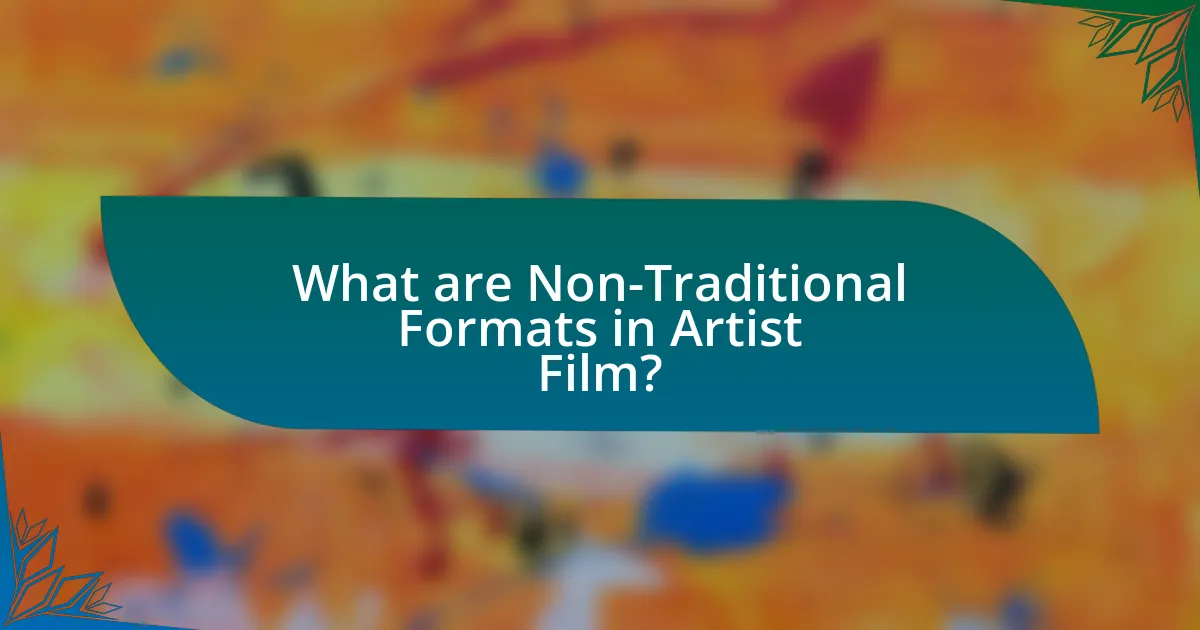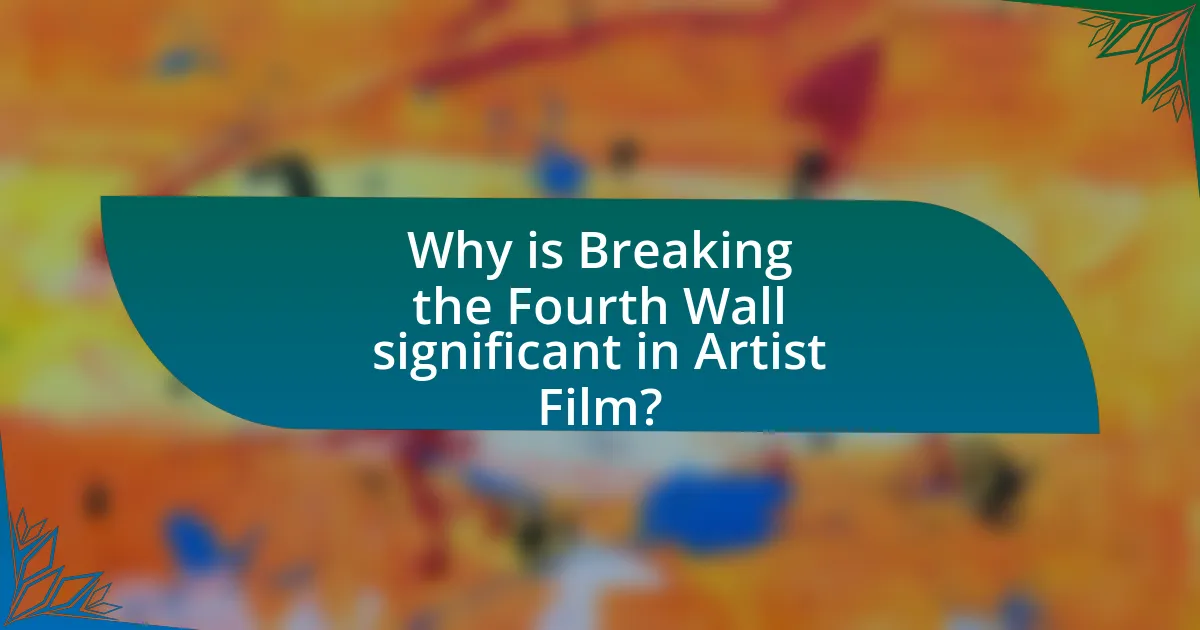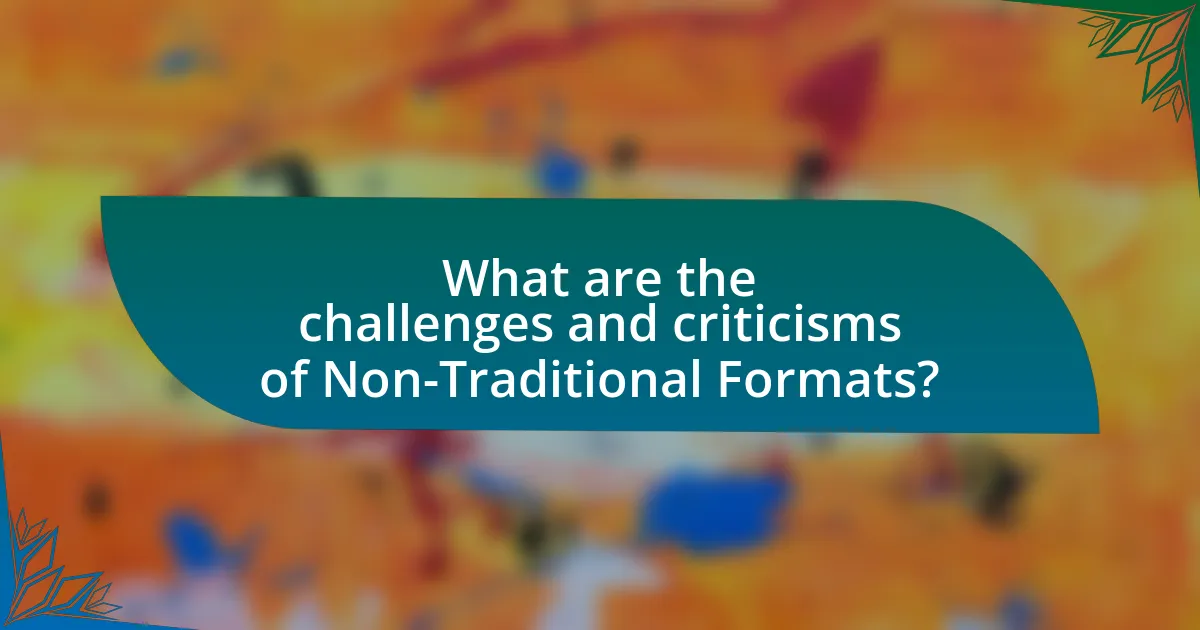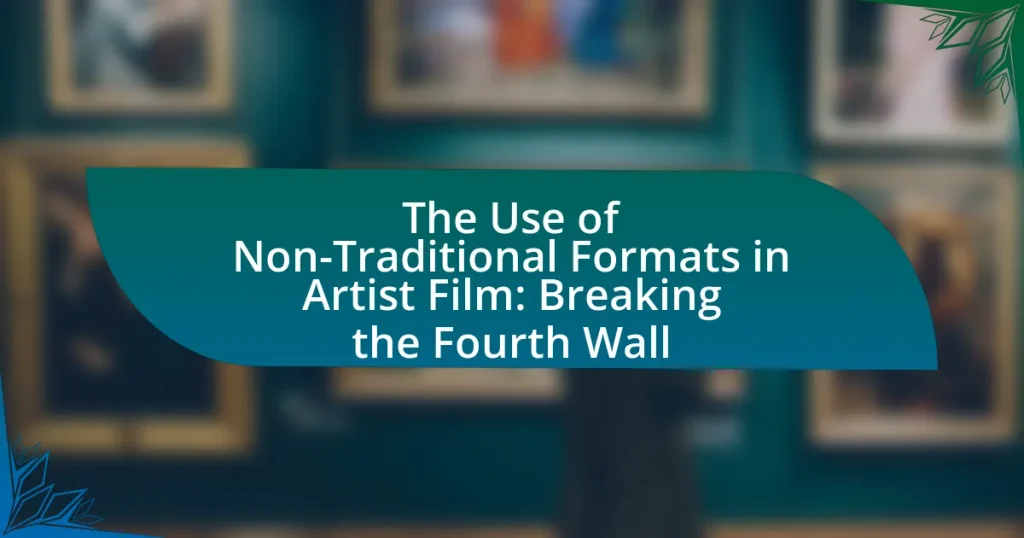The article examines the use of non-traditional formats in artist film, particularly focusing on the technique of breaking the fourth wall. Non-traditional formats diverge from conventional cinematic techniques, incorporating experimental narratives, interactive elements, and multimedia presentations that enhance audience engagement. The discussion highlights how these formats differ from traditional storytelling, the characteristics that define them, and their growing popularity among artists. Additionally, the article addresses the significance of breaking the fourth wall in fostering viewer interaction, the challenges faced by artists in utilizing these formats, and best practices for effectively engaging audiences while balancing innovation and accessibility.

What are Non-Traditional Formats in Artist Film?
Non-traditional formats in artist film refer to innovative approaches that diverge from conventional cinematic techniques and structures. These formats often include experimental narratives, interactive installations, and multimedia presentations that challenge traditional storytelling and audience engagement. For instance, artist films may utilize non-linear timelines, incorporate live performance elements, or blend various media such as video, sound, and sculpture. This approach allows artists to explore themes in unique ways, fostering a deeper connection with viewers and encouraging active participation. The significance of non-traditional formats is evident in the works of artists like Pipilotti Rist and Bill Viola, who have successfully pushed the boundaries of film as an art form.
How do Non-Traditional Formats differ from Traditional Formats?
Non-traditional formats differ from traditional formats primarily in their approach to storytelling and audience engagement. Traditional formats, such as linear narratives in feature films, typically follow a structured plot with clear beginnings, middles, and ends, aiming for a passive viewing experience. In contrast, non-traditional formats, like experimental films or interactive media, often break conventional narrative structures, encouraging active participation and critical thinking from the audience. For example, non-traditional formats may utilize fragmented storytelling, non-linear timelines, or direct address to the viewer, which challenges the audience’s expectations and invites them to engage more deeply with the content. This distinction is evident in artist films that intentionally disrupt the fourth wall, creating a dialogue between the film and its viewers, thereby enhancing the overall impact and meaning of the work.
What characteristics define Non-Traditional Formats in film?
Non-Traditional Formats in film are characterized by their deviation from conventional narrative structures and presentation styles. These formats often include experimental storytelling techniques, such as non-linear narratives, interactive elements, and the blending of various media forms. For example, films that break the fourth wall directly engage the audience, challenging traditional viewer-passive roles and creating a more immersive experience. Additionally, the use of unconventional visual styles, such as mixed media or animation, further distinguishes these films from mainstream cinema. This approach allows filmmakers to explore complex themes and emotions in innovative ways, as seen in works by artists like David Lynch and Maya Deren, who utilize these characteristics to enhance their storytelling.
Why are Non-Traditional Formats gaining popularity among artists?
Non-traditional formats are gaining popularity among artists because they allow for greater creative expression and audience engagement. These formats, such as immersive installations and interactive media, break conventional boundaries of storytelling and viewer participation. For instance, a study by the National Endowment for the Arts in 2020 highlighted that 60% of artists reported using innovative formats to enhance audience interaction, demonstrating a shift towards more participatory art experiences. This trend reflects a broader cultural movement that values experiential and multi-sensory engagement, making non-traditional formats increasingly appealing to contemporary artists.
What role does Breaking the Fourth Wall play in Non-Traditional Formats?
Breaking the Fourth Wall in non-traditional formats serves to create a direct connection between the audience and the narrative, enhancing engagement and self-awareness. This technique allows characters to address the audience directly, blurring the lines between fiction and reality, which can provoke critical thinking about the themes presented. For instance, in artist films, this approach often challenges conventional storytelling methods, inviting viewers to reflect on their role as spectators. The effectiveness of this technique is evidenced by its use in various acclaimed works, such as “Fleabag” by Phoebe Waller-Bridge, where breaking the fourth wall deepens emotional resonance and humor, demonstrating its impact on audience perception and interaction.
How does Breaking the Fourth Wall enhance viewer engagement?
Breaking the Fourth Wall enhances viewer engagement by creating a direct connection between the characters and the audience, fostering a sense of intimacy and involvement. This technique allows characters to acknowledge the audience’s presence, which can evoke emotional responses and provoke critical thinking about the narrative. For instance, studies have shown that when characters address viewers directly, it can lead to increased empathy and investment in the storyline, as seen in works like “Fleabag” and “Deadpool.” These examples illustrate how breaking the fourth wall can transform passive viewing into an interactive experience, ultimately deepening the audience’s connection to the material.
What techniques are used to effectively break the Fourth Wall?
Techniques used to effectively break the Fourth Wall include direct address, self-referential commentary, and audience interaction. Direct address involves characters speaking directly to the audience, creating a sense of intimacy and engagement. Self-referential commentary allows characters to acknowledge their fictional status, often leading to humor or critical reflection on the narrative. Audience interaction can involve inviting viewers to participate in the storyline, further dissolving the barrier between the performance and the audience. These techniques have been employed in various forms of media, such as theater, film, and television, to enhance viewer engagement and provoke thought about the nature of storytelling.

Why is Breaking the Fourth Wall significant in Artist Film?
Breaking the Fourth Wall is significant in Artist Film because it creates a direct connection between the audience and the film, challenging traditional narrative structures. This technique allows filmmakers to engage viewers in a dialogue, prompting them to reflect on the nature of storytelling and their role as spectators. For instance, films like “Anomalisa” by Charlie Kaufman utilize this method to blur the lines between fiction and reality, enhancing emotional resonance and viewer introspection. By breaking this barrier, artist films can subvert expectations and provoke critical thought, making the viewing experience more interactive and thought-provoking.
What impact does Breaking the Fourth Wall have on storytelling?
Breaking the Fourth Wall significantly alters storytelling by creating a direct connection between the audience and the narrative. This technique allows characters to acknowledge the audience’s presence, which can enhance engagement and provoke critical thinking about the story’s themes. For instance, in films like “Ferris Bueller’s Day Off,” the protagonist’s direct address to the camera invites viewers to participate in the narrative, fostering a sense of intimacy and complicity. This interaction can also challenge traditional narrative structures, encouraging audiences to question the nature of reality within the story. By breaking the fourth wall, creators can effectively blur the lines between fiction and reality, leading to a more immersive and reflective viewing experience.
How does it alter the viewer’s perception of reality in film?
Non-traditional formats in artist film alter the viewer’s perception of reality by actively engaging them in the narrative, often breaking the fourth wall to create a more immersive experience. This technique disrupts the conventional boundaries between the audience and the film, prompting viewers to question the authenticity of what they see. For instance, films that directly address the audience or incorporate self-referential elements encourage critical thinking about the medium itself, leading to a heightened awareness of cinematic constructs. Research indicates that such approaches can enhance emotional involvement and provoke deeper reflections on societal norms and personal beliefs, as seen in works by filmmakers like Jean-Luc Godard and Lars von Trier, who utilize these methods to challenge viewers’ expectations and perceptions.
What are some notable examples of this technique in Artist Film?
Notable examples of breaking the fourth wall in artist film include “The Act of Killing” by Joshua Oppenheimer, where subjects directly address the camera, creating a confrontational dialogue about their past actions. Another example is “The Blair Witch Project,” which employs a documentary style that blurs the line between fiction and reality, engaging viewers directly. Additionally, “The Square” by Ruben Östlund features characters who speak to the audience, challenging their perceptions of art and morality. These films exemplify the technique by actively involving the audience in the narrative, prompting reflection on the relationship between viewer and subject.
How does Breaking the Fourth Wall challenge traditional cinematic conventions?
Breaking the Fourth Wall challenges traditional cinematic conventions by directly addressing the audience, thereby disrupting the illusion of reality that films typically create. This technique invites viewers to engage critically with the narrative, as seen in films like “Ferris Bueller’s Day Off,” where the protagonist speaks directly to the camera, creating a sense of intimacy and complicity. By breaking this barrier, filmmakers encourage audiences to reflect on the storytelling process itself, questioning the nature of fiction and reality. This approach contrasts with conventional cinema, which often maintains a clear separation between the narrative and the viewer, reinforcing the immersive experience.
What are the implications for audience expectations?
The implications for audience expectations in the context of non-traditional formats in artist film, particularly those that break the fourth wall, include a heightened demand for engagement and interactivity. Audiences now anticipate a more immersive experience where they are not just passive viewers but active participants in the narrative. This shift is evidenced by the increasing popularity of films that incorporate direct address, interactive storytelling, and unconventional narrative structures, which challenge traditional cinematic norms. As a result, filmmakers must adapt to these evolving expectations by innovating their storytelling techniques to maintain audience interest and satisfaction.
How does this technique influence the relationship between the artist and the audience?
The technique of breaking the fourth wall in artist film significantly enhances the relationship between the artist and the audience by fostering direct engagement and interaction. This approach allows artists to acknowledge the audience’s presence, creating a sense of intimacy and shared experience. For instance, when an artist directly addresses the viewer, it transforms the passive viewing experience into an active dialogue, encouraging audiences to reflect on their own perspectives and interpretations. Research indicates that this technique can lead to increased emotional investment and a deeper connection, as seen in works by artists like Marina Abramović, who often invites audience participation, thereby blurring the lines between performer and spectator.

What are the challenges and criticisms of Non-Traditional Formats?
Non-Traditional Formats in artist film face several challenges and criticisms, primarily related to audience engagement, accessibility, and narrative coherence. Critics argue that these formats can alienate traditional viewers who may struggle to connect with unconventional storytelling methods, leading to a limited audience reach. Additionally, the experimental nature of non-traditional formats often results in a lack of clear narrative structure, which can confuse viewers and detract from the intended message. Furthermore, accessibility issues arise when these formats rely heavily on specific cultural references or avant-garde techniques that may not resonate with a broader audience, limiting their impact. These challenges highlight the tension between artistic innovation and audience comprehension in the realm of non-traditional filmmaking.
What obstacles do artists face when using Non-Traditional Formats?
Artists face several obstacles when using non-traditional formats, including limited audience understanding, technical challenges, and funding issues. Limited audience understanding arises because non-traditional formats often deviate from conventional storytelling methods, making it difficult for viewers to engage or interpret the work. Technical challenges include the need for specialized skills or equipment that may not be readily available, which can hinder the production process. Funding issues are prevalent as non-traditional projects may struggle to secure financial support due to their unconventional nature, leading to difficulties in bringing the artistic vision to fruition.
How do production costs compare to traditional filmmaking?
Production costs in non-traditional filmmaking are generally lower than those in traditional filmmaking. Non-traditional formats often utilize minimalistic approaches, reduced crew sizes, and less expensive equipment, which significantly decreases overall expenses. For instance, a study by the University of Southern California found that independent films, which often employ non-traditional methods, can have budgets as low as $10,000 compared to traditional films that frequently exceed $1 million. This cost efficiency allows artists to experiment with innovative storytelling techniques without the financial burden typically associated with conventional film production.
What are the risks of alienating mainstream audiences?
Alienating mainstream audiences can lead to significant financial losses and reduced cultural impact for artists and filmmakers. When creators prioritize non-traditional formats that diverge from conventional storytelling, they risk losing the interest of a broader audience, which can result in lower box office revenues and diminished viewership. For instance, films that heavily utilize avant-garde techniques may attract niche audiences but fail to resonate with the general public, as evidenced by the mixed commercial performance of experimental films compared to mainstream blockbusters. This alienation can also limit opportunities for future projects, as investors and distributors may be hesitant to support works perceived as too esoteric or inaccessible.
What criticisms are often directed at Non-Traditional Formats?
Criticisms directed at Non-Traditional Formats in artist film often include concerns about accessibility, narrative coherence, and audience engagement. Critics argue that these formats can alienate mainstream audiences due to their experimental nature, making it difficult for viewers to connect with the content. Additionally, some believe that the lack of a conventional narrative structure can lead to confusion, detracting from the overall impact of the film. Furthermore, there are concerns that the emphasis on breaking the fourth wall may disrupt immersion, causing viewers to feel detached rather than engaged with the artistic message.
How do critics perceive the artistic value of these films?
Critics generally perceive the artistic value of films that utilize non-traditional formats and break the fourth wall as innovative and thought-provoking. These films are often praised for their ability to challenge conventional storytelling techniques and engage audiences in a more interactive manner. For instance, films like “Eternal Sunshine of the Spotless Mind” and “Adaptation” have been highlighted for their unique narrative structures and self-referential elements, which critics argue enhance the emotional depth and intellectual engagement of the viewer. Such films are frequently discussed in academic circles, with scholars noting that their artistic merit lies in their capacity to blur the lines between fiction and reality, prompting viewers to reflect on their own experiences and perceptions.
What arguments exist against the effectiveness of Breaking the Fourth Wall?
Arguments against the effectiveness of Breaking the Fourth Wall include the potential disruption of narrative immersion and audience engagement. Critics argue that when characters address the audience directly, it can create a jarring experience that pulls viewers out of the story, undermining emotional investment. For instance, a study by K. M. McGowan in “The Journal of Film and Video” highlights that excessive breaking of the fourth wall can lead to viewer alienation, as it interrupts the flow of the narrative and diminishes the believability of the characters. Additionally, some filmmakers contend that this technique can overshadow the plot, making the storytelling less coherent and detracting from character development.
What best practices can artists follow when utilizing Non-Traditional Formats?
Artists can enhance their work in non-traditional formats by embracing interactivity, which engages audiences more deeply. This approach allows viewers to participate in the narrative, fostering a sense of connection and investment in the artwork. For instance, utilizing technology such as augmented reality or interactive installations can create immersive experiences that challenge conventional viewing practices.
Additionally, artists should consider the context in which their work is presented, as this can significantly influence audience perception. Presenting art in unconventional spaces, such as public areas or online platforms, can reach diverse audiences and provoke new interpretations.
Furthermore, collaboration with other disciplines, such as technology or performance art, can enrich the creative process and result in innovative outcomes. This multidisciplinary approach has been shown to expand the boundaries of artistic expression and engage wider audiences.
In summary, best practices for artists utilizing non-traditional formats include fostering interactivity, considering presentation context, and collaborating across disciplines to create engaging and innovative experiences.
How can artists effectively engage their audience through these formats?
Artists can effectively engage their audience through non-traditional formats by utilizing interactive elements, immersive experiences, and direct communication. These approaches allow artists to break the fourth wall, creating a dialogue between the artwork and the viewer. For instance, interactive installations encourage audience participation, making them active contributors rather than passive observers. Research shows that immersive experiences, such as virtual reality, can enhance emotional engagement, as participants feel a stronger connection to the narrative. Additionally, direct communication methods, like social media interactions or live performances, foster a sense of community and personal investment in the artwork, leading to deeper audience engagement.
What strategies can be employed to balance innovation and accessibility?
To balance innovation and accessibility in artist film, creators can employ strategies such as user-centered design, iterative testing, and collaboration with diverse audiences. User-centered design ensures that films are created with the audience’s needs in mind, making innovative elements more relatable and understandable. Iterative testing allows filmmakers to refine their work based on audience feedback, ensuring that innovative aspects do not alienate viewers. Collaboration with diverse audiences, including those with disabilities, can provide insights that enhance both accessibility and creativity, leading to a more inclusive artistic expression. These strategies have been shown to improve audience engagement and broaden the reach of innovative works in the film industry.


